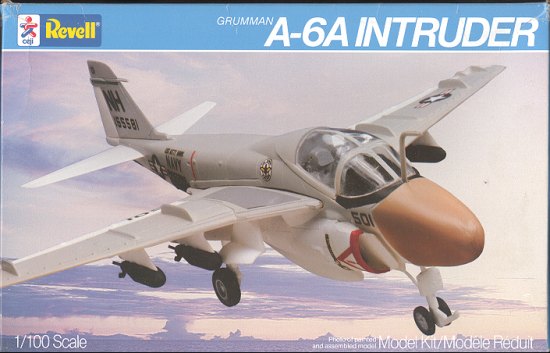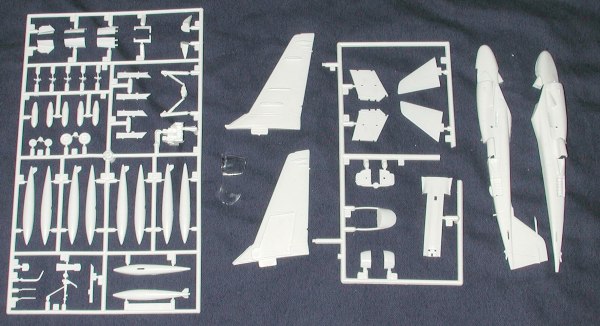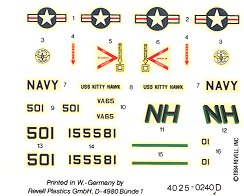
|
KIT: |
Revell 1/100 A-6A Intruder |
|
KIT # |
4025 |
|
PRICE: |
Long OOP - bought at a swap meet |
|
DECALS: |
One aircraft |
|
REVIEWER: |
|
|
NOTES: |
Ex Tamiya mold, I do believe. |

|
HISTORY |
Needing to replace the elderly A-1 Skyraider piston-engined attack plane that dated back to the end of World War II, the US Navy instigated a competition to develop a day/night, all-weather, long-range, low-level, jet-powered attack aircraft. After reviewing eleven designs from eight manufacturers, Grumman's G-128 was selected the winner in 1957, and the company preceeded to develop the A2F-1 (later redesignated A-6A) for both the Navy and Marine Corps.
Unlike most planes of the era designed for supersonic flight and high performance, the A-6 sacrificed speed and maneuverability for exceptional bombing accuracy and payload. The rather conventional design featured a mid-mounted swept wing equipped with full-span slats along the leading edge and nearly full-span single-slotted flaps along the trailing edge. Instead of ailerons, the A-6 wing employed large spoilers located just ahead of the flaps to provide roll control when deflected differentially and to act as lift dumpers when deflected together while the wingtips split open to act as airbrakes.
The bulbous fuselage provided space for a large attack radar, side-by-side seating under the cockpit canopy, two J52 turbojets fed by large cheek inlets, and a sophisticated array of electronic countermeasures and threat receivers. Despite early development troubles, the A-6 emerged as a superb attack aircraft in Vietnam where its advanced avionics suite, heavy payload, large fuel capacity, and sturdy construction made the Intruder one of the most durable and versatile planes in the theater.
The most successful variant was the A-6E equipped with a powerful multi-mode tracking and terrain-following radar and equipped to carry laser-guided bombs. The TRAM upgrade program saw the installation of the Hughes Target Recognition and Attack, Multisensor turret located under the nose and containing a Forward Looking Infrared (FLIR), laser designator, and laser receiver. Further upgrades throughout the 1980s and 1990s allowed the A-6 to carry the latest array of precision guided munitions. Several A-6Es were also fitted with improved cockpit lighting systems compatible with night vision goggles enabling pilots to reduce the low-level cruising altitude from 500 ft (150 m) to 200 ft (60 m) at night.
Although the Navy had shown interest in an upgraded A-6F equipped with
even more capable avionics and a new radar, the program was cancelled
following the decision to build the A-12 Avenger. Grumman's later attempt
to develop a cheaper A-6G also failed, but the Navy did pursue a series
of structural and avionics upgrades to extend the service life of the
A-6E into the mid-1990s. Nevertheless, both the Navy and Marine Corps A-6
fleets were withdrawn following the Gulf War with the final front-line
squadron retired in 1997. The duties of the A-6 were split between the
F/A-18 attack fighter, upgraded models of the F-14 equipped with
precision bombing capability, and the S-3, none of which could replace
the range, payload or tanking capabilities of the Intruder.
|
THE KIT |

As I mentioned, I do believe this is an ex-Tamiya kit. Marketed in 1985
along with other old Tamiya and some of the truly excellent Takara molds,
this kit is one of the better versions done by Tamiya. In all regards, this
is not as detailed a kit as it would have been in 1/72, but it isn't that
bad. It does have some options such as the ability to show the canopy open
as well as open or closed speed brakes. It also has engraved panel lines
and they are rather well done, not being to grossly large for the scale.
Bits such as gear doors are a touch on the thick side for the scale, but
not ridiculously so. There are four wing pylons and a centerline pylon. One
has the choice of either fuel tanks or bombs for those pylons. The bomb s
look a bit odd for a Navy plane. They appear to be the old 750 lb versions
that I don't think were used by the USN, the Navy having Mk 8x versions by
the time the Intruder came on line.
s
look a bit odd for a Navy plane. They appear to be the old 750 lb versions
that I don't think were used by the USN, the Navy having Mk 8x versions by
the time the Intruder came on line.
Instructions are typical non-written types with lots of drawings and generic color information for the various bits and pieces. Naturally, the USN colors of the time were light gull grey and white. Decals are for one aircraft from VA-65 aboard the Kitty Hawk and a rather insipid choice, what with many other more colorful schemes available. The decals themselves are well printed but have yellowed. They should work fairly well, as they'll have to with no other options available. Probably the biggest problem with 1/100 scale is the total lack of aftermarket decals.
|
CONCLUSIONS |
If you are into 1/100 (and a surprising number of people are) then you should be seeking this one.
|
REFERENCES |
If you would like your product reviewed fairly and fairly quickly by a site that has over 200,000 visitors a month, please contact me or see other details in the Note to Contributors.